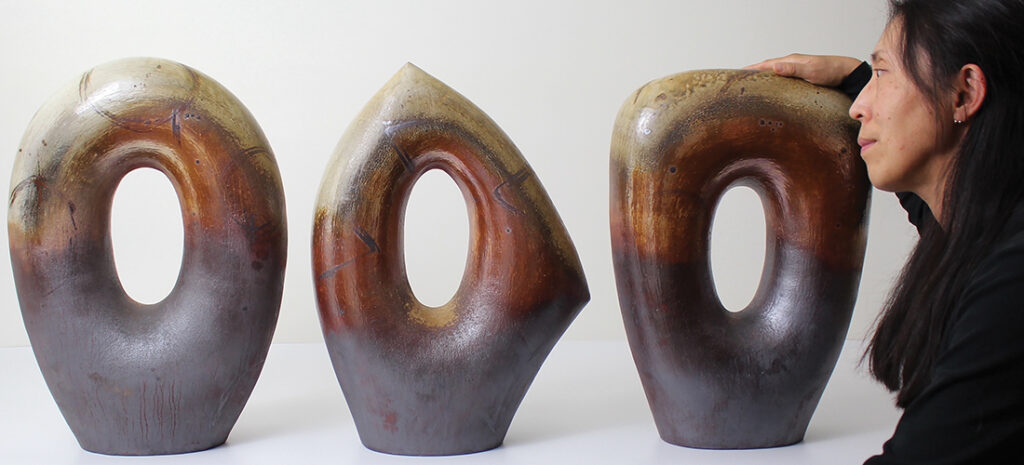Art of the State

Wild Clay, Ancient Art
Takuro and Hitomi Shibata shape pots — and their community
By Liza Roberts
Eighteen years ago, when ceramic artists Takuro and Hitomi Shibata moved to Seagrove from the ancient pottery village of Shigaraki, Japan, they had with them nothing but a couple of suitcases, a rescued stray cat and plans for a short adventure.
Today they are pillars of the community. Hitomi is a respected and prolific Seagrove ceramic artist, and Takuro, a fellow potter and the procurer and refiner of most of the area’s local clay, is a community fulcrum. They live with their two American-born sons on Busbee Road in a striking modernist house designed by a protégé of famed architect Frank Harmon, built in part with their own hands. Their wood-fired kilns are a stone’s throw from its front door, and the tiny farmhouse where they first lived on the property now serves as a gallery for their work. Their former garage is now their studio.
The art they make here and sell under the Studio Touya name is distinctly their own. Hitomi’s sculptural pieces have the rounded, organic shapes of abstract feminine nudes. Takuro’s are distinct for their architectural geometry, acute angles and jutting planes. It’s impossible to see the couple’s pieces side by side and not admire the harmony of their yin and yang.
A reverence for local clay is at the heart of the couple’s individual art and their mutual business. They put that shared love and knowledge into Wild Clay: Creating Ceramics and Glazes from Natural and Found Resources, a book they co-wrote and published with Herbert Press in 2022. Its publication took their local story to an international audience, changing their business and their work in the process.
“We have been very busy doing more exhibitions and workshops outside of North Carolina, nationally and internationally,” Hitomi says. “Especially after releasing our book, we were invited to ceramic conferences, meetings and workshops to talk about our clay stories from Shigaraki to North Carolina.” When so much time on the road meant less time for making pots, the couple decided to refine their work. “We tried to improve the quality of our art,” Hitomi says. “Also, using beautiful wild clays and natural materials, which we have been doing for many years, became even more important for our artistic practices.”
Finding Home
The couple credits the Seagrove community and its native clay for nurturing the art they originally learned in Shigaraki. The first time they saw this place, they had a feeling it would be important to them. “We were surprised,” Hitomi recalls. “There were so many pottery studios. We realized Seagrove was the biggest pottery community in the United States.”
They’d come down from a Virginia artist’s residence on a Greyhound bus at the invitation of Nancy Gottovi (now executive director of nearby arts hub Starworks) and her husband, Seagrove potter David Stumpfle, who had visited Shigaraki a few years earlier.
The Shibatas loved what they saw, but their visas were up.
Two years later, Gottovi called again. She was working with Central Park NC, an organization dedicated to preserving the natural and cultural assets of central North Carolina, and offered Takuro, who has an engineering and chemistry degree, an opportunity to establish a clay factory to serve Seagrove’s potters.
The Shibatas jumped at the chance. People in Seagrove, they believed, truly understood the value of pottery. In other places, Hitomi says, “people love art, but they don’t think that pottery is the same thing as art. But here, people are so crazy about pottery. They love the tradition, they have so much appreciation . . . it’s part of the history of the state.”
The Pottery Ecosystem
Today, Starworks Ceramics is an integral part of the Seagrove pottery ecosystem, and it’s growing. “We went through a tough time during the pandemic,” Takuro says, “but now we have more people working, and it’s a great team. Our clay is getting more popular, and potters and artists support not only our clays, but the story of a clay factory.”
The process is laborious: Takuro takes raw clay dug from the earth and turns it into a viable material. The equipment he and his assistants use to refine it is massive and low-tech, the stuff of a fairy-tale giant’s bakery. Some of it is from the 1940s. There’s a shredder, a mixer, a separator and a vibrating screen; there are things called filter presses and pug mills. All of it fills a cavernous warehouse room. Massive buckets of what looks like sticky dirt go in one end; several days of man and machine power later, neat clay cubes come out the other. These cubes are sold in increasing numbers to potters in Seagrove and around the world.
“Using wild clays for pottery in the studio is a growing trend in American ceramic art education and in small pottery businesses,” Takuro says. “It’s good for people to think about sustainability and the environment. However, these methods have been used and improved for thousands of years all over the world. Nothing is new.”
He hopes his clay and the couple’s book inspires more potters around the country to learn about the clay histories in their own regions: “Our clay story is very personal, and our clay experience doesn’t cover all wild clays, but we heard from readers that many places in the world have interesting histories, communities and people who work in clay. We believe clay is universal.”
At the same time, Takuro knows that what makes and sells at Starworks can’t be found just anywhere. “North Carolina clay is special,” he says. “It’s high in silica, it can be fired at high temperatures and it is from this place.” OH
This is an excerpt from Art of the State: Celebrating the Art of North Carolina, published by UNC Press.
